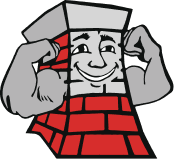How a Cold Winter Can Lead to Chimney Damage
When cold winter weather in Connecticut is below freezing, cars are made ready, plants and water pipes might be covered, and pets are brought inside; but few homeowners consider the damage that might occur to chimneys. Harsh temperatures can damage your chimney system in several ways, sometimes endangering your home and family. Below, learn how cold weather affects chimneys plus steps you can take to prevent chimney damage.
Spalling, Due to Moisture Intrusion
 Chimneys are vulnerable to moisture year-around. The most critical step in the prevention of chimney damage is to keep moisture out of your chimney system. Water can enter a chimney structure in the following ways:
Chimneys are vulnerable to moisture year-around. The most critical step in the prevention of chimney damage is to keep moisture out of your chimney system. Water can enter a chimney structure in the following ways:
- The mortar has deteriorated
- The chimney crown is cracked
- A chimney cap hasn’t been installed, or it leaks
- The chimney flashing doesn’t have the needed waterproof seal
Once the water is inside the porous chimney materials, it freezes and thaws, expands and contracts in winter. The movement causes spalling, which means that the brick face flakes and breaks off. The weakened masonry can ultimately result in the collapse of the entire chimney structure, and it sometimes happens during the winter season.
How to Prevent Spalling
Routine inspection and maintenance of your chimney can help you to prevent moisture intrusion because signs of damage can be discovered and repaired at beginning stages. Also, waterproofing can be applied to a damage-free chimney. The waterproofing material provides an extra layer of protection against moisture.
An Animal gets Inside the Chimney
 Another essential thing to do during frigid Connecticut winters is to bundle up when outside and use a heating system indoors. Wild animals often seek to escape the extreme cold, too. Various critters are often attracted to the warmth radiating from chimneys. Raccoons, snakes, birds, and other animals sometimes enter the flue, if there is no chimney cap or if the appliance is in a state of disrepair. Animals are endangered when they can’t get back out of a chimney; and the situation is potentially hazardous for the people inside the home, as well. If birds build nests, it creates blockage and could act as fuel for a perilous chimney fire. Nests and animals need to be removed before lighting another fire.
Another essential thing to do during frigid Connecticut winters is to bundle up when outside and use a heating system indoors. Wild animals often seek to escape the extreme cold, too. Various critters are often attracted to the warmth radiating from chimneys. Raccoons, snakes, birds, and other animals sometimes enter the flue, if there is no chimney cap or if the appliance is in a state of disrepair. Animals are endangered when they can’t get back out of a chimney; and the situation is potentially hazardous for the people inside the home, as well. If birds build nests, it creates blockage and could act as fuel for a perilous chimney fire. Nests and animals need to be removed before lighting another fire.
It’s essential to call a professional if an animal gets into your chimney. The animals are sometimes diseased, and experts know how to get the job done safely. There may also be debris, including excrement, which should be removed. To keep animals out, the chimney cap should also be repaired or one should be installed.
The Stack Effect
When there is an air pressure difference between the inside and outside of a home, the stack effect can occur. Cold air can enter the chimney to replace warm air that has exited the flue. The cold column of air can prevent the smoke from fires from going up the chimney. For this reason, a chimney needs to be primed before lighting a fire. It involves holding a lit newspaper torch up to the open damper until the cold air moves out, which make require two or three tries.
A sealed damper in the chimney helps to keep your home’s warm air inside and the cold air outside. If air is getting through your damper, it should be repaired or replaced.
Contact Northeastern Chimney, Central CT Chimney Experts
For a chimney inspection, chimney repair, or chimney cap installation or if there’s an animal seeking warmth inside your chimney, contact the chimney experts at Northeastern Chimney. Contact 860-659-0937 today to ensure that you can light a warm fire in your home during cold Connecticut winter weather.


